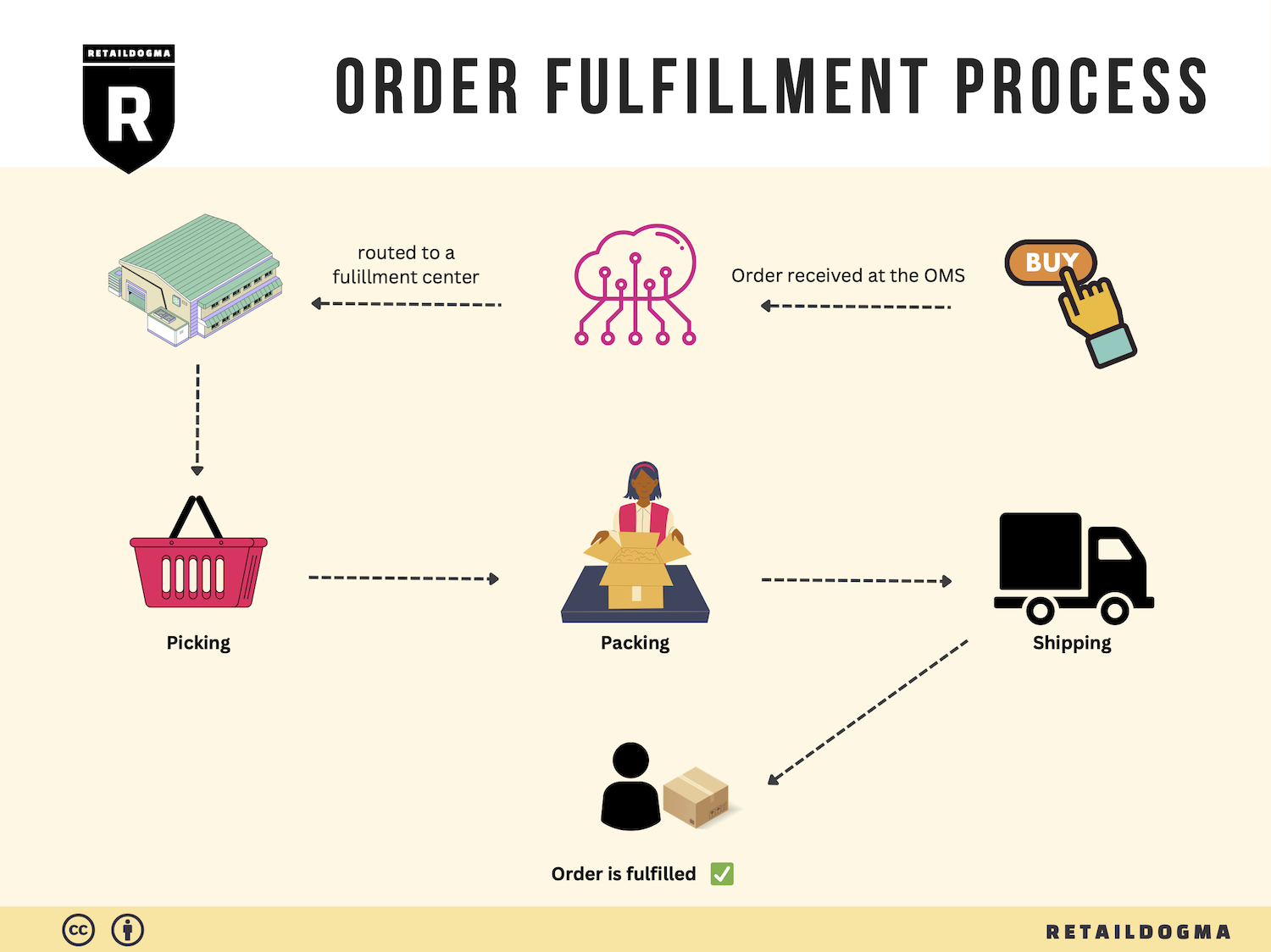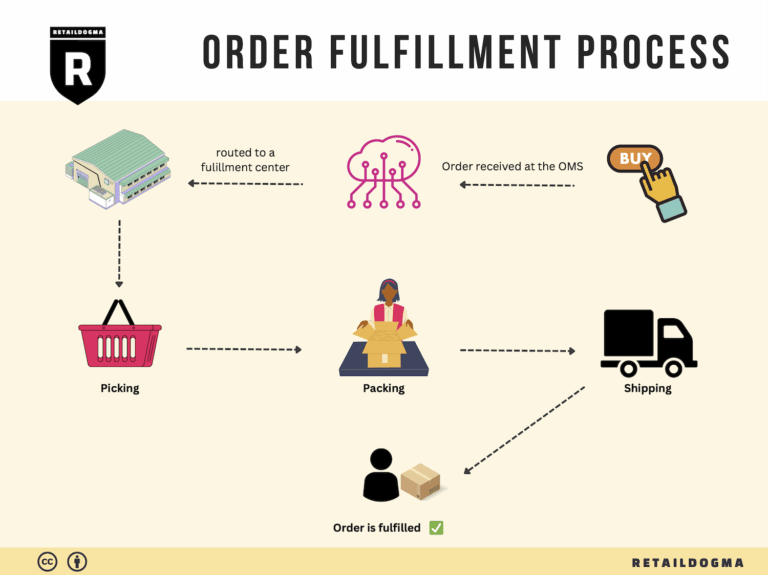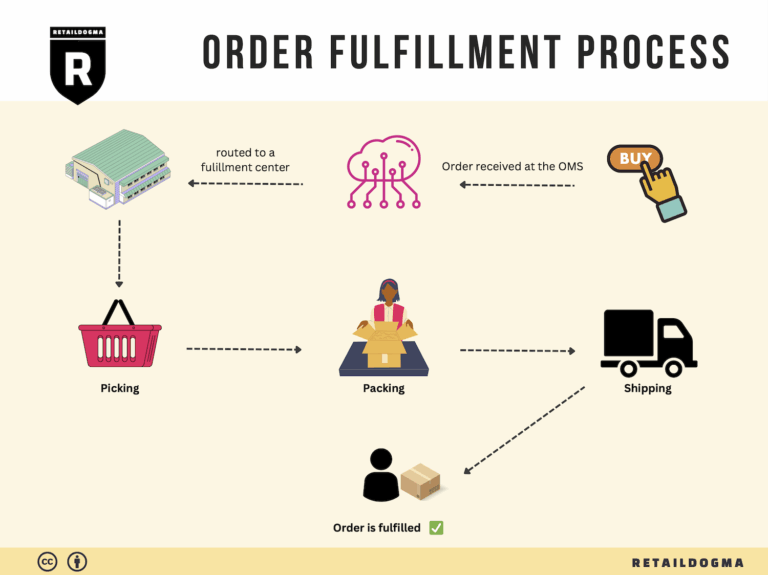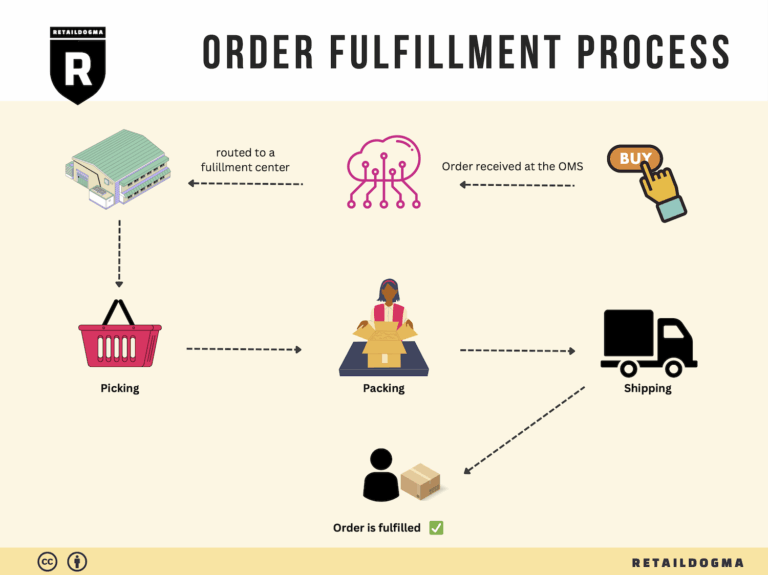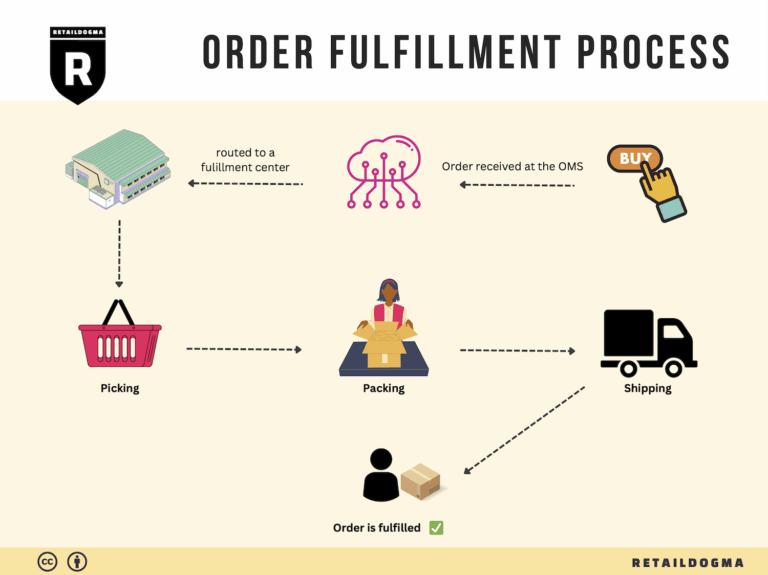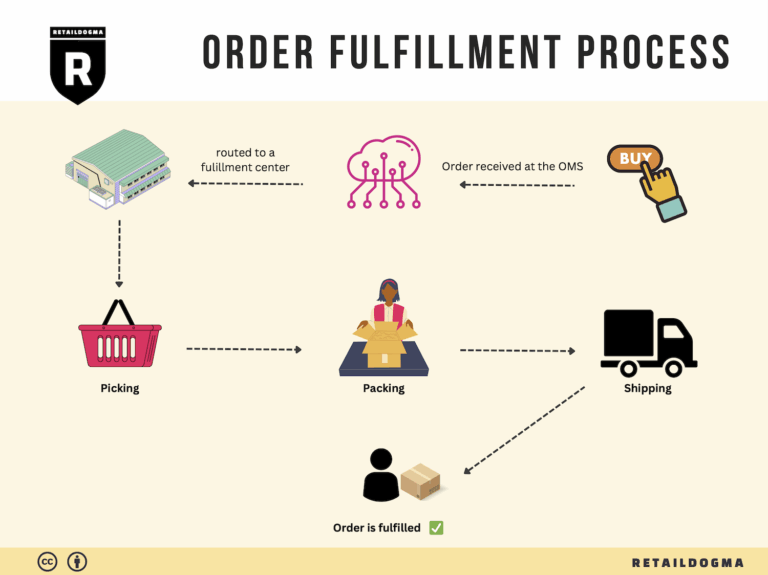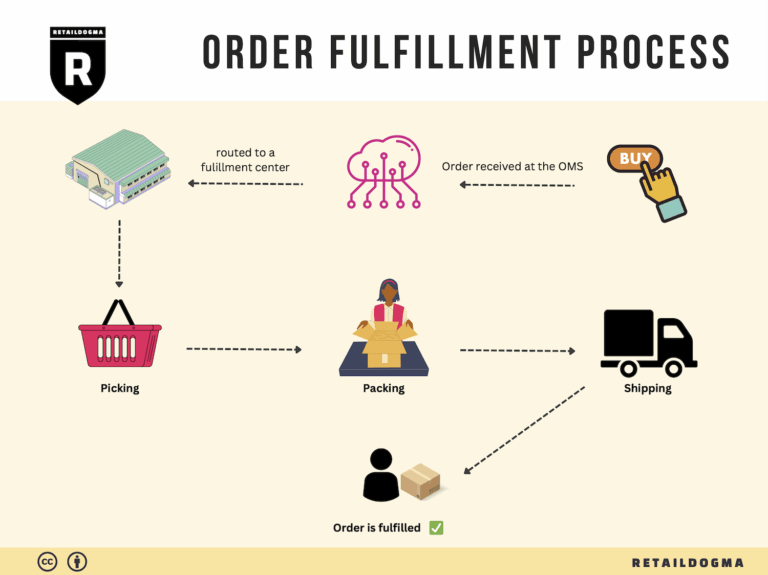Ecommerce Fulfillment Services: The Ultimate Guide (2025)
What is E-commerce Fulfillment? An Introduction for Growing Businesses
Navigating the Challenges of Order Fulfillment
As your e-commerce business begins to grow, the excitement of increasing sales can quickly turn into a daunting challenge—especially when it comes to packing and shipping orders. Many entrepreneurs find themselves overwhelmed by the logistics of fulfillment, spending countless hours managing inventory, processing orders, and dealing with shipping logistics. This is where understanding e-commerce fulfillment becomes essential.
Fulfillment is simply the process of getting a product from your warehouse to your customer’s doorstep. It encompasses everything from inventory management and order processing to packaging and shipping. For growing businesses, mastering this process is crucial not only for operational efficiency but also for maintaining customer satisfaction.
In this guide, we will explore the various fulfillment models available to you, including Third-Party Logistics (3PL) and Fulfillment by Amazon (FBA). Each model has its pros and cons, and selecting the right one can significantly impact your business’s scalability and profitability. We will also delve into the core services involved in e-commerce fulfillment, such as pick and pack, shipping, and returns management, which are vital for ensuring that your customers receive their orders accurately and on time.
Choosing the right fulfillment partner is a decision that can shape your business’s future. We will provide practical insights into what to look for in a fulfillment provider, including technology integration, pricing transparency, and service reliability. Understanding these factors will enable you to make informed decisions that align with your growth objectives.
Pricing is another critical aspect we will cover. E-commerce fulfillment costs can vary widely depending on the services you require and your shipping volume. We will break down common pricing structures and offer tips on how to estimate your fulfillment expenses accurately, helping you avoid unexpected costs that can eat into your margins.
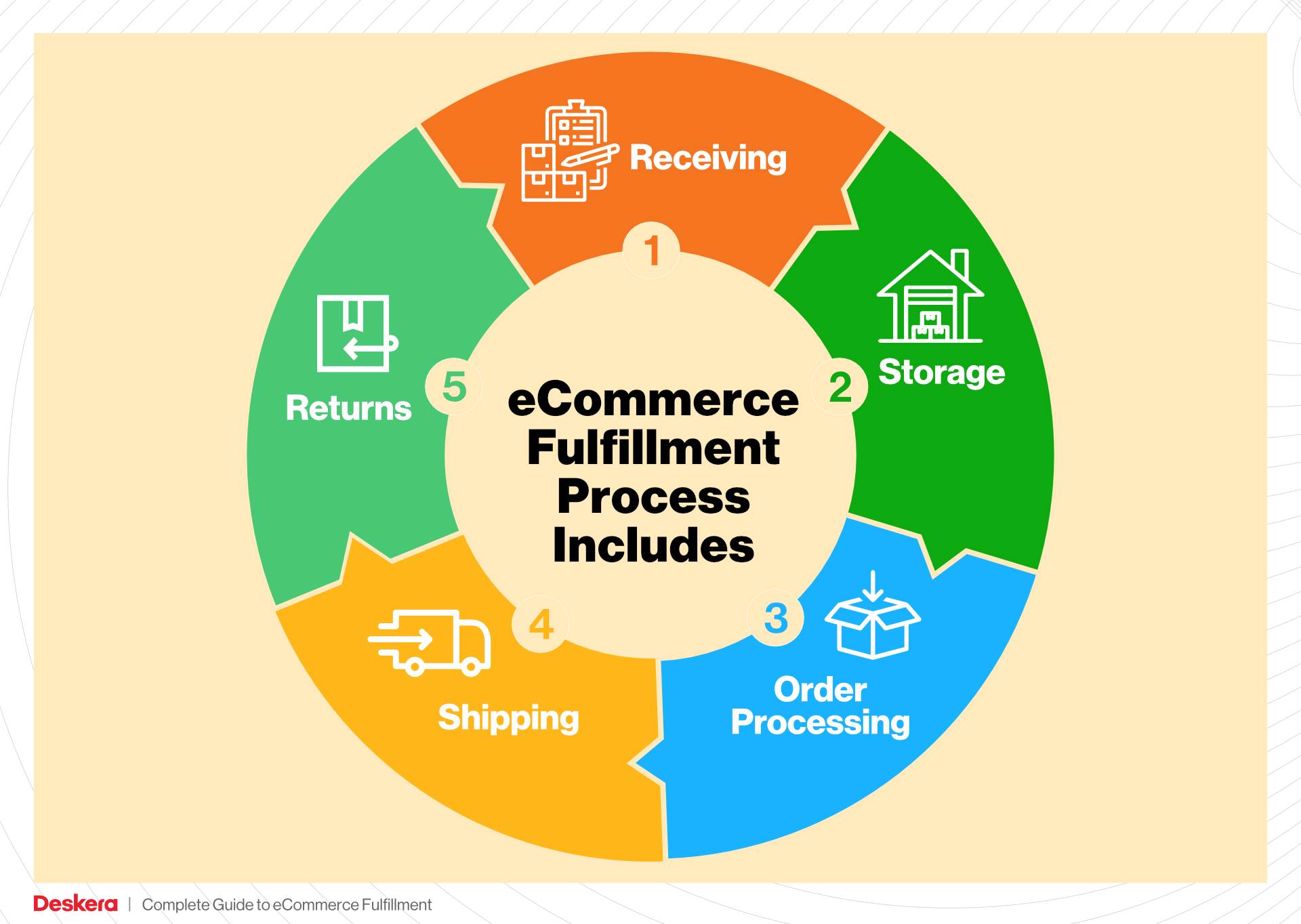
Ultimately, this guide aims to empower you as a business owner or operations manager to make smart, strategic decisions about your logistics. By understanding the ins and outs of e-commerce fulfillment, you can streamline your operations, enhance customer satisfaction, and focus on scaling your business without the chaos of logistics holding you back.
What You’ll Learn In This Guide
- What is E-commerce Fulfillment? An Introduction for Growing Businesses
- The Order Fulfillment Process: From ‘Buy’ Button to Customer’s Door
- Comparing Fulfillment Models: In-House vs. 3PL vs. Dropshipping
- A Deep Dive into Amazon FBA: Pros, Cons, and Who It’s For
- Core Services Offered by Fulfillment Centers
- How to Choose a Fulfillment Partner: A 6-Point Checklist
- Understanding Fulfillment Pricing: A Breakdown of Common Fees
- Frequently Asked Questions (FAQs) about Fulfillment
- Conclusion: Is Outsourcing Fulfillment the Right Move for Your Business?
- Important Disclaimer
The Order Fulfillment Process: From ‘Buy’ Button to Customer’s Door
1. Receiving Inventory
The order fulfillment process begins with the receiving of inventory, which is crucial for establishing a reliable supply chain. When products arrive at the fulfillment center, they undergo a thorough inspection to ensure that they match the purchase order. This involves checking quantities, quality, and compliance with any specific regulations, especially for sensitive items like supplements or cosmetics.
During this stage, every product is assigned a Stock Keeping Unit (SKU), a unique identifier that streamlines inventory management. Accurate receiving is vital because discrepancies can lead to stockouts or overstock situations, impacting customer satisfaction and operational efficiency. Furthermore, utilizing Advanced Shipping Notifications (ASN) helps prepare the warehouse for incoming shipments, enhancing the speed and accuracy of the receiving process.
2. Warehouse Storage
Once the inventory is received and verified, the next step is warehouse storage. This involves placing products in designated areas within the fulfillment center, optimized for easy access and efficient order processing. Proper organization is key; products should be stored based on their turnover rates, size, and shipping frequency.
Utilizing intelligent storage solutions—like climate-controlled environments for sensitive items—ensures product quality is maintained. Effective warehouse storage not only maximizes space but also reduces the time needed for order picking later on. By implementing real-time inventory tracking systems, businesses can monitor stock levels and receive alerts for low inventory, preventing stockouts that could lead to missed sales opportunities.
3. Order Picking
With products stored and ready for fulfillment, the next phase is order picking. This process involves retrieving items from the warehouse based on customer orders. Efficient picking is essential as it directly affects order accuracy and processing speed.
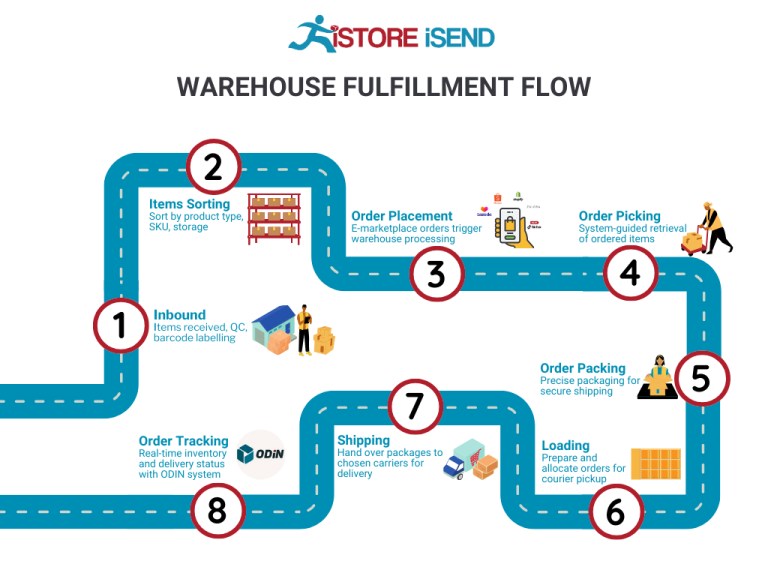
Businesses typically utilize pick lists, which are detailed documents that outline the items and quantities needed for each order. Advanced fulfillment centers may employ automated picking systems or robotics to enhance speed and accuracy, further reducing human error. Efficient order picking not only expedites the fulfillment process but also improves customer satisfaction by ensuring that the correct items are shipped promptly.
4. Order Packing
After items are picked, they move to the order packing stage. This step is critical in ensuring that products are securely packaged to prevent damage during transit. Proper packing also reflects on the brand’s image; well-packaged orders enhance customer experience and encourage repeat business.
During packing, businesses often implement custom packing solutions tailored to the specific products being shipped. For instance, subscription boxes may require unique packing to maintain presentation. Additionally, using the right packaging materials can optimize shipping costs and reduce waste. Ensuring that packing is done accurately and efficiently is paramount, as it can directly impact shipping times and return rates.
5. Shipping & Delivery
The final step in the order fulfillment process is shipping and delivery. Once orders are packed, they are labeled and handed over to carriers for transportation to the customer’s doorstep. This stage is vital as it determines the speed and reliability of delivery, which are crucial factors in customer satisfaction.
Utilizing a global carrier network allows businesses to secure competitive shipping rates while ensuring timely delivery. Moreover, implementing shipping software can help optimize routes and track packages in real time, providing customers with updates on their order status. Effective shipping strategies not only enhance customer experience but also allow businesses to scale operations efficiently, adapting to varying order volumes without compromising service quality.
By following these five steps—receiving inventory, warehouse storage, order picking, order packing, and shipping & delivery—e-commerce businesses can establish a streamlined order fulfillment process that enhances operational efficiency and boosts customer satisfaction. Each step is interconnected, and optimizing them collectively is essential for scaling your business effectively.
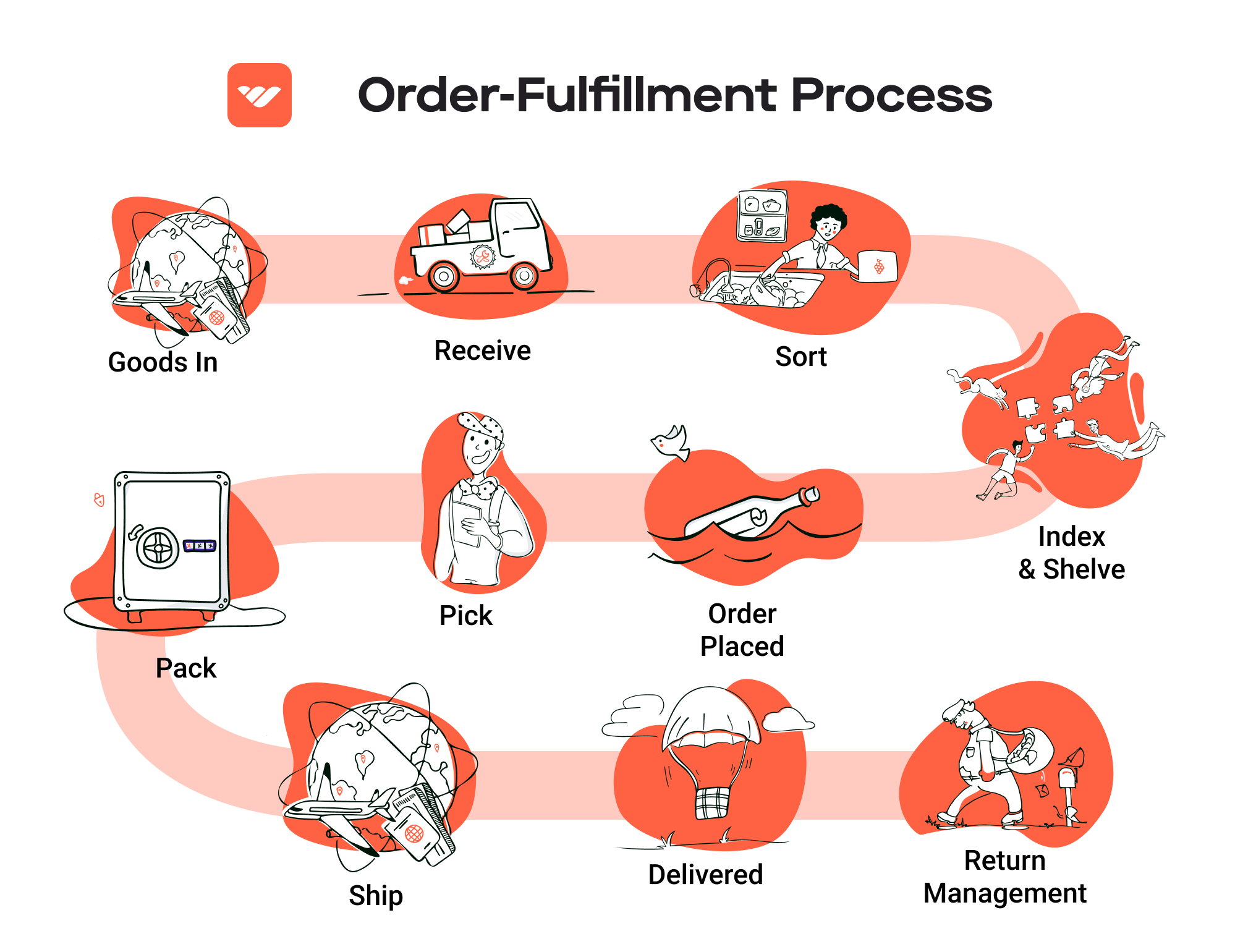
Comparing Fulfillment Models: In-House vs. 3PL vs. Dropshipping
Fulfillment Model Comparison
| Model | Who Handles Inventory | Best For (Business Stage) | Key Advantage | Key Disadvantage |
|---|---|---|---|---|
| In-House Fulfillment | Business Owns Inventory | Startups to Established Brands | Full control over inventory and processes | High overhead costs and resource demands |
| Third-Party Logistics (3PL) | 3PL Provider Manages Inventory | Growing to Scaling Brands | Scalable solutions with expertise | Less control over logistics and branding |
| Dropshipping | Supplier Handles Inventory | Startups and Small Businesses | Low startup costs and minimal risk | Lower profit margins and dependency on suppliers |
In-House Fulfillment
In-house fulfillment refers to managing all aspects of order fulfillment within your own facilities. This model is typically adopted by startups and established brands that want to maintain complete control over their inventory, packing processes, and shipping. The key advantage of in-house fulfillment is the ability to customize every aspect of the fulfillment process, including packaging, branding, and customer service. This level of control can enhance customer satisfaction and loyalty, as businesses can implement their unique brand experience at every touchpoint.
However, this model comes with significant disadvantages. The initial investment in warehousing, technology, and staffing can be substantial. Businesses must also manage ongoing operational costs, including rent, utilities, and labor, which can strain resources, especially for smaller companies. Additionally, as order volumes grow, the need for advanced logistics solutions can lead to complexities that may require further investment in systems and processes.
Third-Party Logistics (3PL)
Third-party logistics (3PL) providers handle the storage, packing, and shipping of products for businesses. This model is ideal for brands that are in a growth phase and looking to scale their operations without the burden of managing logistics themselves. By partnering with a 3PL, businesses can leverage the provider’s expertise, technology, and established infrastructure. Key advantages include reduced overhead costs, as companies avoid the expenses associated with maintaining a warehouse and staff, and access to advanced logistics solutions that can streamline fulfillment processes.
On the downside, using a 3PL can lead to reduced control over the fulfillment process. Businesses must rely on the provider to maintain quality standards, manage inventory accurately, and adhere to shipping timelines. This can create challenges in maintaining brand consistency and customer satisfaction, particularly if the 3PL does not align with the company’s values or operational standards. Furthermore, businesses may face challenges related to pricing transparency and potential hidden fees, which can complicate budgeting and financial forecasting.
Dropshipping
Dropshipping is a fulfillment model where retailers sell products without holding any inventory. Instead, when a customer places an order, the retailer purchases the item from a third-party supplier, who then ships it directly to the customer. This model is particularly appealing for startups and small businesses with limited capital, as it requires minimal upfront investment. The key advantage of dropshipping is the ability to offer a wide range of products without the financial risk associated with unsold inventory. This flexibility allows businesses to test new products and pivot quickly based on market demand.
However, dropshipping also presents significant challenges. Profit margins are often lower compared to in-house fulfillment or 3PL models because retailers must pay the supplier’s wholesale prices. Additionally, retailers have little control over inventory levels, shipping times, and product quality, which can lead to customer dissatisfaction if suppliers fail to meet expectations. Reliance on third-party suppliers can also create vulnerabilities in the supply chain, as issues such as stockouts or shipping delays directly impact the retailer’s reputation and customer experience.
Conclusion
Choosing the right fulfillment model is critical for e-commerce businesses aiming to scale effectively. Each model—In-House Fulfillment, Third-Party Logistics (3PL), and Dropshipping—offers unique advantages and disadvantages that should be carefully considered in the context of your business goals, financial resources, and operational capabilities. By understanding the nuances of each approach, e-commerce business owners can make informed decisions that align with their growth strategies and customer satisfaction objectives.
A Deep Dive into Amazon FBA: Pros, Cons, and Who It’s For
Understanding Fulfillment by Amazon (FBA)
Fulfillment by Amazon (FBA) is a service provided by Amazon that allows sellers to store their products in Amazon’s fulfillment centers. Amazon then takes care of storage, packaging, shipping, and customer service on behalf of the seller. This service enables e-commerce businesses to leverage Amazon’s extensive logistics network, ensuring that products reach customers quickly and efficiently.
When a customer places an order for a product fulfilled by Amazon, the item is picked, packed, and shipped directly from an Amazon warehouse. Additionally, FBA sellers benefit from Amazon’s customer service and return management, making it a compelling option for many e-commerce businesses.
How FBA Works
-
Setup and Inventory: Sellers create an Amazon seller account and select FBA as their fulfillment method. They then prepare their products according to Amazon’s guidelines and ship them to designated Amazon fulfillment centers.
-
Storage: Once the inventory is received, it is stored in Amazon’s warehouses. Sellers can monitor their inventory levels through their Amazon seller account.
-
Order Processing: When a customer places an order, Amazon handles the entire fulfillment process. This includes picking the product from the warehouse, packing it, and shipping it to the customer.
-
Customer Service: Amazon manages customer service inquiries, including handling returns and refunds. This allows sellers to focus on other aspects of their business.
-
Payment and Fees: After the product is sold, Amazon deducts fees for its services, including storage fees and fulfillment fees, from the seller’s account. The remaining amount is then credited to the seller.
Pros of Using Amazon FBA
-
Prime Eligibility: One of the most significant advantages of FBA is that products fulfilled by Amazon are eligible for Amazon Prime. This means they can be offered with free two-day shipping, which attracts more customers and can lead to increased sales.
-
Customer Trust: Amazon is a well-established and trusted brand. By using FBA, sellers can leverage this trust, as customers are more likely to purchase from a seller whose products are fulfilled by Amazon. The assurance of reliable shipping and customer service enhances the purchasing experience.
-
Multi-Channel Fulfillment: FBA allows sellers to fulfill orders from multiple sales channels, not just Amazon. This means that if a seller has a Shopify store or sells on eBay, they can still use Amazon’s fulfillment network to handle those orders, streamlining their logistics.
-
Scalability: FBA provides a scalable solution for e-commerce businesses. As order volumes increase, sellers can easily scale their operations without the need for significant investment in logistics infrastructure.
-
Efficient Returns Management: Amazon handles all return requests and processes returns on behalf of sellers, which can simplify the logistics and enhance customer satisfaction.
Cons of Using Amazon FBA
-
High Fees: While FBA can provide value, it also comes with various fees that can add up quickly. Sellers must pay for storage fees, fulfillment fees per unit, and additional charges for long-term storage. These costs can significantly eat into profit margins, especially for low-margin products.
-
Strict Inventory Rules: Amazon has stringent requirements regarding inventory management. Sellers must adhere to specific guidelines regarding labeling, packaging, and shipping. Failure to comply can result in additional fees or penalties.
-
Commingling Risks: FBA uses a commingling inventory model, meaning that products from different sellers may be stored together. While this can streamline logistics, it also poses a risk if a seller’s products are mixed with defective or counterfeit items from other sellers, potentially harming their reputation.
-
Loss of Control: When using FBA, sellers relinquish some control over the fulfillment process. This can lead to challenges in managing inventory levels and responding to customer service issues, as these are handled by Amazon.
-
Potential for Stockouts: If inventory levels are not managed properly, sellers risk running out of stock in Amazon’s warehouses. This can lead to lost sales and decreased visibility in Amazon’s search results, affecting overall performance.
Who is FBA Best For?
Amazon FBA is particularly well-suited for:
-
Small to Medium-Sized Businesses: Businesses that lack the resources to manage their own logistics can benefit significantly from FBA, allowing them to focus on product development and marketing while Amazon handles fulfillment.
-
Brands Looking to Scale: Companies looking to expand their reach and increase sales quickly can leverage Amazon’s vast customer base and fulfillment capabilities.
-
Sellers of High-Volume Products: For sellers with a consistent flow of orders, the fees associated with FBA can be offset by the increased sales volume and efficiency of Amazon’s logistics network.
-
E-commerce Entrepreneurs: New entrepreneurs looking to enter the e-commerce space can take advantage of FBA’s infrastructure without needing to invest heavily in their logistics operations.
-
Brands with Seasonal Products: Businesses that experience seasonal spikes in demand can benefit from FBA’s scalability, allowing them to manage fluctuating inventory needs without long-term commitments.
In conclusion, Fulfillment by Amazon presents a powerful opportunity for e-commerce sellers to streamline their logistics and enhance customer satisfaction. However, it’s essential to carefully consider the associated costs and operational implications to determine if it aligns with your business model and growth strategy.
Core Services Offered by Fulfillment Centers
Inventory Management & Warehousing
Inventory management and warehousing are foundational services offered by fulfillment centers that ensure e-commerce businesses can maintain optimal stock levels and efficient storage solutions. This service involves the systematic tracking and organizing of inventory within a secure warehouse environment. Fulfillment centers utilize advanced inventory management software that provides real-time visibility into stock levels, locations, and movements.
The benefits of effective inventory management are multifaceted. First, it minimizes the risk of stockouts and overstock situations, which can lead to lost sales or increased holding costs. By employing just-in-time inventory strategies, businesses can reduce storage costs and enhance cash flow. Moreover, precise inventory tracking aids in forecasting demand, enabling businesses to make informed purchasing decisions. This is particularly critical for seasonal products or items with fluctuating demand.
Additionally, fulfillment centers often offer climate-controlled warehousing, which is essential for products sensitive to temperature and humidity, such as beauty and wellness items. This compliance with industry standards (e.g., FDA/GMP) ensures that products are stored safely, preserving their quality and extending their shelf life.
Pick and Pack Services
Pick and pack services are at the core of the order fulfillment process, involving the selection (picking) of ordered items from the warehouse and their subsequent packaging (packing) for shipment. Fulfillment centers utilize automated systems and technology to maintain accuracy and efficiency, often achieving error rates of less than 0.1%.
The primary benefit of efficient pick and pack services is speed. In today’s competitive e-commerce landscape, customers expect fast delivery. By streamlining the picking and packing process, fulfillment centers can significantly reduce order processing times, ensuring that products are shipped quickly and accurately. This capability is crucial for businesses aiming to enhance customer satisfaction and loyalty.
Furthermore, fulfillment centers often provide customizable packing solutions that align with a brand’s image. Whether it’s a subscription box or promotional kits, the right packaging can enhance the unboxing experience and reinforce brand identity. This attention to detail not only boosts customer satisfaction but also encourages repeat business.
Kitting and Assembly
Kitting and assembly services involve the grouping of individual items into ready-to-ship kits or bundles. This could include assembling product sets, creating promotional bundles, or preparing subscription boxes. Fulfillment centers manage this process by efficiently organizing components, ensuring that each kit is assembled correctly and packaged for shipment.
The benefits of kitting and assembly services extend beyond mere convenience. First, they allow businesses to offer unique product combinations that can attract new customers and drive sales. For instance, a beauty brand might create a skincare regimen kit that combines multiple products at a discounted price, appealing to customers looking for comprehensive solutions.
Additionally, kitting can improve operational efficiency. By preparing kits in advance, fulfillment centers can reduce the time spent on individual order processing. This pre-assembly approach allows businesses to better manage their inventory and respond quickly to customer demands, particularly during peak seasons. It also simplifies the logistics of shipping, as fewer SKUs need to be handled during order fulfillment.
Returns Management (Reverse Logistics)
Returns management, often referred to as reverse logistics, is a critical service that involves handling product returns from customers. This process includes inspecting returned items, sorting them for restocking or disposal, and managing exchanges or refunds. Fulfillment centers streamline this process to minimize the impact of returns on a business’s bottom line.
The benefits of efficient returns management are significant. First, a well-organized returns process enhances customer satisfaction. When customers find it easy to return products, they are more likely to make future purchases. This is particularly important for e-commerce businesses, where customer trust and loyalty can be fragile.
Moreover, effective returns management can also provide valuable data insights. Analyzing return reasons helps businesses identify product issues or customer dissatisfaction, enabling them to make necessary improvements. Additionally, fulfillment centers often process returns quickly, allowing businesses to restock sellable items promptly, thus minimizing losses.
In conclusion, the core services offered by fulfillment centers—inventory management and warehousing, pick and pack services, kitting and assembly, and returns management—are vital for e-commerce businesses aiming to scale effectively. By leveraging these services, businesses can enhance operational efficiency, reduce costs, and ultimately improve customer satisfaction, positioning themselves for sustainable growth in a competitive market.
How to Choose a Fulfillment Partner: A 6-Point Checklist
Location & Warehouse Network
Why It Matters:
The geographical location of your fulfillment partner’s warehouses can significantly impact shipping times and costs. A strategically placed warehouse network allows for quicker delivery to your customers, which can enhance satisfaction and reduce shipping expenses.
Questions to Ask:
– Where are your fulfillment centers located, and how does that align with my primary customer base?
– Do you have multiple warehouses to facilitate faster shipping?
– How do you handle shipping logistics across different regions or countries?
Technology & Integrations
Why It Matters:
In today’s fast-paced e-commerce environment, the technology stack of your fulfillment partner is crucial for efficiency. A partner that offers robust software solutions can streamline order processing, inventory management, and reporting. Seamless integration with your existing e-commerce platforms (like Shopify, WooCommerce, or Magento) is essential for real-time inventory updates and order tracking.
Questions to Ask:
– What technology platforms do you support for integration?
– Can your system provide real-time inventory tracking?
– How do you ensure data security and compliance with regulations?
Specializations (e.g., Cold Storage, Oversized Items)
Why It Matters:
Different products have unique storage and handling requirements. If your business involves selling items that require special conditions, such as temperature-sensitive products or oversized items, it’s essential to partner with a fulfillment center that specializes in those areas.
Questions to Ask:
– Do you have facilities for temperature-controlled storage?
– How do you handle fragile or oversized items?
– Can you accommodate specific packaging requirements for my products?
Scalability & Capacity
Why It Matters:
As your business grows, your fulfillment needs will change. A partner that can scale with you ensures you won’t outgrow their capabilities. This includes the ability to handle increased order volumes, seasonal spikes, or new product lines without compromising service quality.
Questions to Ask:
– What is your current capacity, and how quickly can you scale up if my order volume increases?
– Do you have a track record of handling peak seasons for other clients?
– How do you manage inventory during rapid growth phases?
Pricing and Contracts
Why It Matters:
Understanding the pricing structure of your fulfillment partner is critical to maintaining profitability. Transparent pricing helps you forecast expenses accurately and manage your budget effectively. Additionally, being aware of contract terms and any potential hidden fees can prevent unexpected costs.
Questions to Ask:
– Can you provide a detailed breakdown of your pricing model?
– Are there any hidden fees I should be aware of, such as storage or handling fees?
– What is the length of the contract, and what are the terms for cancellation or modification?
Customer Support & Reviews
Why It Matters:
Exceptional customer service is essential for a successful partnership. Your fulfillment partner should offer reliable support to address issues that may arise promptly. Additionally, researching reviews and testimonials can provide insights into their reliability and service quality.
Questions to Ask:
– What support channels do you offer (phone, email, live chat)?
– How quickly can I expect a response to an inquiry or issue?
– Can you provide references or case studies from similar businesses?
Conclusion
Choosing the right fulfillment partner is a critical decision that can significantly impact your e-commerce business’s success. By considering the factors outlined in this checklist, you can make an informed choice that aligns with your operational needs and growth ambitions. Engage in thorough discussions with potential partners, and don’t hesitate to request demonstrations of their systems or processes to ensure they meet your standards. Ultimately, a well-chosen fulfillment partner will not only support your logistics but also enhance your overall customer experience, helping you scale your business confidently.
Understanding Fulfillment Pricing: A Breakdown of Common Fees
Initial Setup Fees
When partnering with a third-party logistics (3PL) provider, the initial setup fees are often the first cost to consider. These fees can cover a range of services, including onboarding processes, system integration, and account setup. Generally, initial setup fees can range from a few hundred to several thousand dollars, depending on the complexity of your requirements and the provider’s technology stack.
These fees typically include:
- Account Creation: Setting up your brand’s profile in the fulfillment provider’s system.
- Software Integration: Connecting your e-commerce platform (like Shopify or WooCommerce) with the 3PL’s warehouse management system (WMS) for real-time inventory tracking and order processing.
- Training and Support: Initial training sessions for your staff on how to use the 3PL’s systems and tools.
To minimize initial costs, ensure you have a clear understanding of your requirements and ask the provider for a detailed breakdown of what the setup fee includes.
Receiving Fees
Receiving fees are charged for the intake of inventory into the fulfillment center. This fee is typically calculated based on the number of units or pallets received. The costs can range from $0.25 to $1.00 per item, depending on the complexity of the receiving process and the volume of goods being handled.
Factors influencing receiving fees include:
- Volume of Inventory: Higher volumes may lead to lower per-unit costs due to economies of scale.
- Condition of Goods: If items require special handling or inspection, this can increase costs.
- Speed of Processing: Urgent receiving requests may incur additional charges.
A clear understanding of your inventory flow will help you negotiate more favorable receiving fees, especially if you anticipate high volumes.
Storage Fees (per pallet/bin)
Storage fees are charged for the space your inventory occupies within the fulfillment center. These fees can be calculated on a per-pallet or per-bin basis, with typical costs ranging from $0.40 to $0.60 per cubic foot. The total storage fee depends on the size and volume of your products, as well as the duration they are stored.
Considerations for storage fees include:
- Inventory Turnover: Fast-moving products may incur lower storage costs due to shorter storage durations.
- Seasonal Inventory: If you have products that are only needed at certain times of the year, consider negotiating storage fees for off-peak times.
- Climate-Controlled Storage: If your products require special conditions (e.g., temperature-sensitive items), expect higher storage fees.
To manage storage costs effectively, regularly review your inventory levels and turnover rates, and communicate your needs with your 3PL provider.
Pick & Pack Fees (per item/order)
Pick & pack fees are incurred when items are selected from inventory and packaged for shipment. This fee is usually calculated on a per-order or per-item basis, typically ranging from $0.75 to $1.25 per item. Factors that can influence these fees include:
- Complexity of Orders: Orders with multiple items may incur higher fees due to the extra time and labor involved.
- Special Packaging Requirements: Custom packaging or kitting services can lead to additional costs.
- Volume Discounts: Higher order volumes often qualify for discounted rates.
To optimize your pick & pack costs, streamline your product offerings and consider using a simple packing method that minimizes handling time.
Shipping Fees
Shipping fees are one of the most variable costs associated with fulfillment and can significantly impact your bottom line. These fees depend on various factors, including the shipping carrier, destination, package dimensions, weight, and shipping speed.
Key components of shipping fees include:
- Carrier Rates: 3PLs often have negotiated rates with major carriers, which can be passed on to you without markup.
- Shipping Zones: Costs increase with distance; strategically placing inventory closer to your customer base can reduce shipping fees.
- International Shipping: If you ship globally, be mindful of tariffs and duties, which can add to your overall shipping costs.
To manage shipping fees effectively, consider using a fulfillment partner that provides transparent pricing and the ability to analyze shipping zones, allowing you to make informed decisions about where to store your inventory.
Conclusion: Tips for Getting an Accurate Quote
To obtain an accurate quote from a fulfillment provider, consider the following tips:
- Assess Your Needs: Understand your average order volume, product types, and specific storage requirements.
- Request Detailed Breakdown: Ask for a detailed explanation of all potential fees and how they are calculated.
- Negotiate: Don’t hesitate to negotiate fees, especially if you anticipate high volumes or long-term partnerships.
- Consider Future Growth: Discuss scalability options and how pricing might change as your business grows.
- Utilize Fulfillment Calculators: Many providers offer online calculators that can help you estimate costs based on your unique needs.
By thoroughly understanding the various fulfillment fees and asking the right questions, you can ensure a partnership that supports your growth while keeping costs manageable.
Frequently Asked Questions (FAQs) about Fulfillment
1. What is a 3PL (Third-Party Logistics) provider?
A 3PL provider is a company that offers outsourced logistics services, encompassing everything from warehousing and inventory management to order fulfillment and shipping. By partnering with a 3PL, e-commerce businesses can leverage specialized expertise and technology to streamline their operations, reduce costs, and focus on core business activities.
2. What’s the difference between a warehouse and a fulfillment center?
While both warehouses and fulfillment centers store goods, their functions differ significantly. A warehouse primarily serves as a storage space for products, focusing on inventory management and bulk storage. In contrast, a fulfillment center is designed specifically for processing orders, which includes picking, packing, and shipping products directly to customers. Fulfillment centers are typically equipped with advanced technology for order management and often offer additional services like returns processing.
3. How do fulfillment services work?
Fulfillment services involve several key steps: storing your inventory in a fulfillment center, receiving orders from your sales channels, picking the ordered items, packing them securely, and shipping them to customers. Many fulfillment providers integrate directly with your e-commerce platform, allowing for real-time inventory tracking and order updates, which enhances efficiency and accuracy.
4. How much do fulfillment services cost?
The cost of fulfillment services varies based on several factors, including order volume, the type of products being handled, and specific services required. Typically, costs may include order processing fees, item picking fees, storage fees (usually charged per cubic foot), and returns processing fees. For example, a general breakdown might include $2.50 per order for processing and $0.75 to $1.25 per item picked. It’s essential to discuss your unique needs with a provider to get an accurate estimate.
5. Can I use a fulfillment service for international shipping?
Yes, many fulfillment providers, including Launch Fulfillment, offer international shipping solutions. They can assist with customs documentation, duties, and compliance, ensuring a smooth process for shipping products globally. It’s crucial to choose a fulfillment partner experienced in international logistics to avoid potential pitfalls.
6. What types of businesses benefit from fulfillment services?
Fulfillment services are beneficial for a wide range of businesses, particularly e-commerce retailers, subscription box companies, and brands in regulated industries like beauty and supplements. Businesses experiencing rapid growth or those looking to scale operations efficiently often find fulfillment services invaluable for managing increasing order volumes without compromising customer experience.
7. How quickly can I start using fulfillment services?
The onboarding time for fulfillment services can vary, but many providers, including Launch Fulfillment, offer rapid onboarding processes that can be completed within days. This typically involves integrating your e-commerce platform, setting up inventory in the fulfillment center, and establishing shipping methods. The goal is to get your operations running smoothly as quickly as possible.
8. How do I know if I need a fulfillment service?
If your business is processing 3000 or more orders per month, it may be time to consider a fulfillment service. Additionally, if you find it challenging to manage inventory, shipping logistics, or customer returns effectively, a 3PL can help streamline these processes and enhance your operational efficiency.
9. What should I look for in a fulfillment provider?
When selecting a fulfillment provider, consider factors such as their experience in your industry, technology capabilities (like real-time inventory tracking), pricing transparency, shipping options, and customer service. It’s also beneficial to look for providers who offer specialized services that align with your business needs, such as handling temperature-sensitive products or managing returns effectively.
10. How can fulfillment services improve my customer experience?
Fulfillment services can significantly enhance customer experience by ensuring timely and accurate order processing. With streamlined operations and real-time inventory management, fulfillment providers can reduce errors and shipping times, leading to higher customer satisfaction. Additionally, efficient returns processing helps maintain a positive brand reputation, as customers appreciate hassle-free returns.
Conclusion: Is Outsourcing Fulfillment the Right Move for Your Business?
Assessing the Benefits of Outsourcing Fulfillment
Outsourcing fulfillment can be a transformative decision for e-commerce businesses looking to scale. One of the most significant advantages is time savings. By entrusting your logistics to a third-party fulfillment service, you can redirect your focus towards core business activities like marketing, product development, and customer engagement. This shift not only enhances productivity but also drives growth.
Scalability is another crucial benefit. As your order volumes increase, a dedicated fulfillment partner can seamlessly handle the surge without compromising service quality. Leading providers offer advanced technology and infrastructure that can support scaling from hundreds to thousands of orders per month. This flexibility ensures you can meet customer demands without the hassle of managing logistics in-house.
Moreover, partnering with a fulfillment expert means accessing specialized knowledge and resources. These providers are equipped with the latest technology for inventory management, shipping optimization, and error reduction, which can significantly improve your operational efficiency. Their expertise allows you to navigate complexities such as international shipping, compliance, and returns management—areas that can be particularly challenging for growing businesses.
Choosing the Right Partner
Selecting the right fulfillment partner is paramount to your growth strategy. Look for a provider that aligns with your business goals, offers transparent pricing, and has a proven track record in your industry. Conduct thorough research, read client testimonials, and request quotes to find a partner that can effectively support your logistics needs.
Call to Action
Now is the time to evaluate your current shipping processes. Conduct an audit to identify inefficiencies and potential cost savings. Ask yourself whether your in-house capabilities can keep pace with your growth ambitions. If not, consider reaching out to a fulfillment service to explore how they can enhance your operations and drive your business forward. Take the first step towards a more efficient and scalable fulfillment strategy today.
Important Disclaimer
⚠️ Important Disclaimer
The information in this guide is for educational purposes. Fulfillment services, pricing, and platform features change frequently. Always conduct your own due diligence and consult with providers directly before making business decisions.
